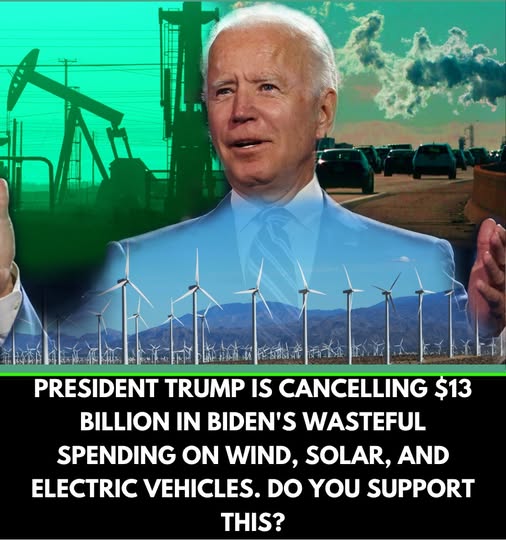A proposal circulating in political discussions—suggesting the cancellation of roughly $13 billion in federal spending for wind, solar and electric-vehicle initiatives—has sparked a new wave of debate about the direction of U.S. energy policy. While the details of the plan vary depending on who is describing it, the core question remains the same: Should the federal government scale back support for clean-energy programs in favor of other national priorities?

The proposal comes at a time when the United States is navigating a complex energy landscape. On one hand, renewable technologies have become more affordable and continue to attract significant private-sector investment. On the other, concerns remain around grid reliability, long-term costs, and the speed at which the nation can realistically transition away from fossil fuels. Supporters and critics of the proposed funding cuts both frame their arguments around these broader strategic tensions.
According to those advocating for the cancellation, federal spending on wind, solar and electric-vehicle programs has grown rapidly in recent years—sometimes faster than infrastructure, labor supply, or domestic manufacturing capacity can keep up. They argue that suspending or reducing this funding would give regulators, utilities and manufacturers time to evaluate what is working and what is not. For some policymakers, the proposal is seen not as a rejection of clean energy but as an attempt to slow the pace of federal intervention and allow the market to adjust more naturally.
Supporters of the cuts also raise fiscal concerns. With federal deficits remaining high and economic pressures still affecting American households, they argue that the government should be cautious about long-term spending commitments. From this perspective, scaling back the $13 billion allocation could be part of a broader push to prioritize budget discipline. Advocates also say that redirecting funds toward energy reliability—such as grid modernization, domestic fuel production, or advanced nuclear research—may offer more immediate benefits.
Critics of the proposal, however, warn that eliminating or pausing federal investments at this stage could slow progress in sectors that have only recently gained momentum. They point out that renewable-energy industries now support hundreds of thousands of jobs across manufacturing, construction and technology development. Reducing federal support, they argue, would introduce uncertainty at a time when companies are beginning to build long-term business strategies around clean-energy demand.
For states that have attracted new solar factories, wind-turbine assembly facilities or electric-vehicle battery plants, the concern is especially acute. Many of these projects rely on stable policy environments to secure financing and move forward. Even a temporary shift in federal direction, critics note, could cause companies to delay expansion plans or reevaluate hiring.
Beyond economic impacts, some analysts say the proposal raises questions about America’s energy independence. As renewable technologies become more competitive, supporters argue that domestic clean-energy production helps reduce reliance on imported fuels and insulate the U.S. from geopolitical shocks. A slowdown in federal investment, they contend, could leave the country more vulnerable to global energy price fluctuations.
Another key dimension in the debate is grid stability. While renewable sources have grown significantly, they still face challenges related to intermittency. Opponents of the cuts acknowledge these challenges but argue that the solution is not to reduce investment but to pair renewables with storage technologies, upgraded transmission lines, and smarter grid management. Without long-term support, they warn, these complementary technologies may struggle to mature.
Public opinion on clean-energy spending adds another layer of complexity. Polls in recent years show broad but uneven support for renewables, with enthusiasm varying significantly across political and regional lines. Rural communities, for example, often express concerns about land use, while urban areas tend to favor EV adoption. Policymakers are therefore navigating a landscape where economic, cultural and environmental priorities differ widely depending on local conditions.
As the debate continues, energy analysts emphasize that the long-term outcome will depend less on any single funding decision and more on the broader policy framework that follows. Whether federal support is reduced, maintained or restructured, industry experts say the United States will need a coherent strategy to integrate traditional and renewable energy sources, strengthen the grid, and ensure affordability for consumers.
For now, the proposal to cancel $13 billion in clean-energy spending underscores a defining tension in contemporary U.S. policymaking: how to balance fiscal caution, technological innovation, and the pressing need for a resilient energy system. The coming months will likely bring further debate, more detailed plans, and continued scrutiny from industries, lawmakers and the public as the nation considers its next steps in shaping the future of American energy.